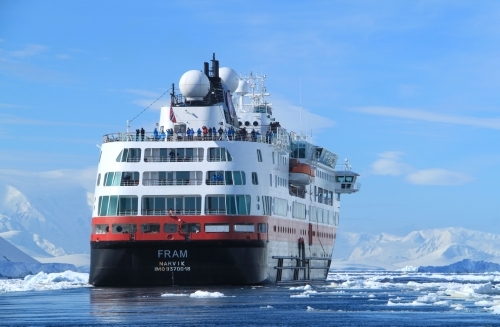 Language is an amazing thing – our English word ‘hurtle’ is likely to be related to the Norwegian word for express or fast, thus the meaning of Hurtigruten is express or fast route. Those Vikings have plenty to answer for when it comes to our language today!
Language is an amazing thing – our English word ‘hurtle’ is likely to be related to the Norwegian word for express or fast, thus the meaning of Hurtigruten is express or fast route. Those Vikings have plenty to answer for when it comes to our language today!
Hurtigruten was formally created as a company in 2006, merging two Norwegian shipping lines OVDS and TFDS which had ships operating in north Norway for 120 years. It is a region that has depended on transport by sea to reach the far-flung communities of the islands and fjords since it was inhabited. Just taking a close look at the coastline from Bergen to Kirkenes, some 1352 nautical miles, over half of it north of the Arctic Circle, it is riddled with inlets and sounds, making transport by land all but impossible two centuries ago. The coastal route taken by ships is known as National Highway No 1 further enforcing its importance to the 34 communities it serves along the way.
 In fact from the mid 1850s, selected ships on the Hurtigruten were given state subsidy to deliver post and act as a ferry service, transporting people and cargo too, a ‘kombinerte’ ship indeed. It was in the summer of 1893 that the first steamship, DS Vesteraalan, left Trondheim for Hammerfest, as a result of the Norwegian government offering permission for a regular route to be sailed. Captain Richard With rose to the challenge, taking 67 hours to make the journey. He later built a hotel at Spitsbergen and the ‘Sportsman Route’ from there to Hammerfest was born.
In fact from the mid 1850s, selected ships on the Hurtigruten were given state subsidy to deliver post and act as a ferry service, transporting people and cargo too, a ‘kombinerte’ ship indeed. It was in the summer of 1893 that the first steamship, DS Vesteraalan, left Trondheim for Hammerfest, as a result of the Norwegian government offering permission for a regular route to be sailed. Captain Richard With rose to the challenge, taking 67 hours to make the journey. He later built a hotel at Spitsbergen and the ‘Sportsman Route’ from there to Hammerfest was born.
By 1908, the pioneering route ran from Bergen to Kirkenes, up in the far north near the Russian border, with tourists as well as locals taking passage on the ships. Indeed, 3 classes of cabin were available with separate dining rooms for each. The coronation of King Oscar II in Trondheim in 1873 and his travels along the coast, followed by journalists from across Europe, most likely had a big influence on the development of tourism here.
 The Hurtigruten continued service, with daily departures from Bergen in place by 1936. The Second World War wreaked havoc with the fleet, with 9 out of 15 ships being lost, several having been used by the government for transport during hostilities. After the war, new ships with diesel engines were commissioned and the coastal express was back in service. By 1952 Hutigruten was carrying 500,000 passengers, using modern engines.
The Hurtigruten continued service, with daily departures from Bergen in place by 1936. The Second World War wreaked havoc with the fleet, with 9 out of 15 ships being lost, several having been used by the government for transport during hostilities. After the war, new ships with diesel engines were commissioned and the coastal express was back in service. By 1952 Hutigruten was carrying 500,000 passengers, using modern engines.
 The MS Kong Herald, launched in 1993, saw the advent of new ships, with 9 out of 11 being built in the following 10 years. Greenland was a new port of call from 2007 along with the addition of the expedition vessel, MS Fram, which took on voyages to Antarctica and Svarlbard from 2010.
The MS Kong Herald, launched in 1993, saw the advent of new ships, with 9 out of 11 being built in the following 10 years. Greenland was a new port of call from 2007 along with the addition of the expedition vessel, MS Fram, which took on voyages to Antarctica and Svarlbard from 2010.
The ships today are still very much ‘kombinerte’, and the epitome of a multipurpose ship, transporting vehicles, cargo, chilled and frozen goods as well as passengers. They are very much integral to the coastal communities of Norway, whilst also providing tourists with 5-star cruise accommodation and an unrivalled experience.
Silver Travel Advisor recommends Hurtigruten











